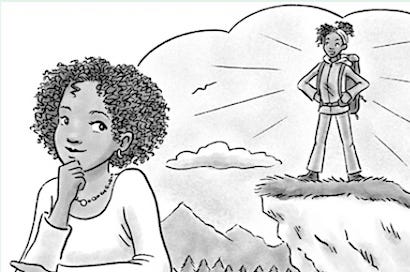MW Substack 025: Motivation. Risk aversion.
The best motivation strategies enhance students' sense of competence and intrinsic desire to learn. Promoting academic risk-taking is a key step.
Welcome to MiddleWeb Substack. It’s a twice-monthly, topical, five-minute read for middle grades educators, featuring a selection of MiddleWeb’s most popular and influential articles, a book review, and a noteworthy 4-8 resource or project we’ve spotted. That’s it!
►MOTIVATION
If motivation to learn is intrinsic, what's the teacher's role?
As we skimmed through our archives to put together articles about motivation, we were struck by how many of them focused on feedback as a major tool in helping students motivate themselves.
"Teachers are feedback machines – we do it all day long!” writes classroom teacher and international blogger Larry Ferlazzo in What Kind of Feedback Best Motivates Students? In this excerpt from his 2023 book The Student Motivation Handbook: 50 Ways to Boost an Intrinsic Desire to Learn, Ferlazzo focuses on the kind of feedback that's particularly effective at enhancing students’ sense of competence and encouraging intrinsic motivation. He notes:
Feedback to support a growth mindset needs to focus on praising specific actions and the effort that went into them, including learning strategies that students use – not on giving evaluative judgments about what kind of person you think the student might be.
And what about critical feedback? Ferlazzo writes:
The process-praising model might be fairly easy for teachers to remember and do. But what about when we have to give more critical feedback? How can we do that and promote a growth mindset, or at least help ignite some intrinsic motivation?
Ferlazzo goes on to suggest two strategies: "plussing" and "wise feedback."
More ideas about motivation from two experts:
‘What Do I Get If I Do It?’ The Cost of Rewards
Do rewards help kids learn better? Motivation expert Dr. Debbie Silver argues instead for the effective use of positive, constructive feedback to foster creativity, active involvement and intrinsic motivation. Included: cases where extrinsic rewards may make sense. Also see Debbie's post, Empowering Our Kids To Motivate Themselves.
5 Keys to Motivating Struggling Learners
Supporting and motivating struggling students is a challenge that seems to grow over time. In this article, author and engagement expert Barbara Blackburn looks at five keys that can help teachers build motivation and persistence while also setting high expectations. Also see Barbara's post, Value and Success Can Build Student Motivation.
Regie Routman “believes that we are most fully ourselves when ‘teaching, learning, and living are interwoven and seamlessly integrated.’ To show us this full self, she shares stories that might help us navigate our own worlds.“ – Read Sarah Cooper’s review of The Heart-Centered Teacher.
►RISK AVERSION
There are no shortcuts around struggle.
"We know and say and even hang posters about how valuable and welcome mistakes are in our classrooms," writes Colleen Cruz, author of Risk. Fail. Rise. A Teacher’s Guide to Learning from Mistakes (Heinemann, 2020).
From the time kids first step into school until the time they leave, we are telling them that mistakes are part of the learning process and that everyone will make them. Kids as young as five know the difference between fixed and growth mindset. And yet… I don’t know of a single educator who does not worry about how risk averse students are.
In her article for MiddleWeb, Creating a Culture that Welcomes Mistakes, Cruz shares five "simple things" teachers can do to create classrooms that welcome risk-taking in the name of learning, and where teachers and students expect and celebrate inevitable mistakes.
Here are more ideas about overcoming risk aversion:
8 Ways to Help Tweens Take Academic Risks
Students in the middle grades think in polarities and will go to great lengths to avoid embarrassment, writes author and school counselor Phyllis Fagell. But with the right supports, they can learn to take risks – asking questions, joining discussions and learning more.
How to Teach Students to Grapple with the Math
Mona Iehl’s students were shocked when she first asked them to grapple with math problems BEFORE they received instruction. Then, to her surprise, “they got out the blocks, and drew pictures, and tried!” Her trust in productive struggle grew as she saw their confidence and willingness to take risks increase. She learned "there are no shortcuts around struggle."
How to Spark Student Innovation in STEM
Innovative thinking can be taught, says science educator Anne Jolly. She shares five interrelated strategies to overcome fear of failure and spark exploration in STEM class, including creating a safe space for learning, promoting risk-taking, building effective teams, and more.
►ELSEWHERE
Can we be motivated and still not make the effort?
At his popular Education Week column Classroom Q&A, Larry Ferlazzo invited his own assistant principal, Antoine Germany, to share a fresh perspective on the question of motivation...the need to also focus on effort. "We are motivated, sometimes highly motivated to lose weight or to eat healthier, yet we don’t show much effort toward that goal. Why?" Read: Student Motivation Is a Perennial Concern. What Are We Missing? (EdWeek is subscription-based but offers free monthly reads.)
►OUR BOOK REVIEW
Turning It Around: Small Steps or Sweeping Changes to Create the School Your Students Deserve. By Todd Whitaker and Courtney Monterecy.
How can we realize the school our students deserve? With tools and action strategies that can work in any school, Turning It Around by Todd Whitaker and award-winning principal Courtney Monterecy is a valuable addition to the literature on school improvement, writes former principal and leadership expert Dr. Ron Williamson. Read the complete review.
►NEXT TIME
Lots and lots of books.
We'll share 10 themed articles that include specific middle grades and YA fiction and nonfiction book recommendations. Dozens and dozens of teacher-screened texts for lessons and class libraries!





Great cross-disciplinary topic filled with a insights and suggestions from a variety of educators. I’ll save that one!